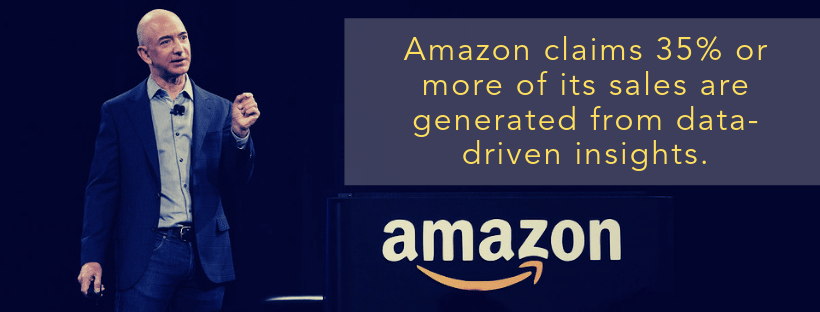Overview
As ecommerce proliferates globally, digital merchants are constantly bombarded by data from a multitude of channels and sources. Every minute of every day 73K online transactions are made, more than $7M is left in abandoned carts, and nearly $11M is spent on retail. And, it’s estimated that in 2020, 1.7MB of data will be created every second for every person on Earth. For aspiring brands, this presents an equally massive opportunity and challenge at the same time.
We know that today’s leading enterprise ecommerce businesses, such as Amazon and Zappos, have long been extracting value from their data for strategy and innovation. In fact, Amazon claims 35% or more of its total sales are generated from data-driven insights.
Enterprise retailers also have the benefit of massive financial resources and can hire teams of data scientists to analyze data using cutting-edge technologies that many smaller merchants simply can’t afford.

Accordingly, ecommerce data analytics remain an underutilized strategy downmarket. Ecommerce merchants searching for ways to differentiate or for a competitive advantage should look to their data as an untapped source of opportunity.
The purpose of this guide is to show aspiring brands how they can take a page from the enterprise retailers and find actionable insight hidden in their customer data. (So keep reading!)
A Data-Driven Approach
One fact that’s been reinforced in our many discussions with ecommerce marketers is that it’s a battlefield out there. Consumers are fickle. Their attention spans are getting shorter. Social media advertising is more costly and less effective. All this adds to a digital landscape where attracting, converting and retaining customers is harder than ever.
Think this doesn’t apply to your brand or target market? We’ve worked with many merchants who had rapid growth in their early stages by generating quality traffic from a single channel (like Facebook) and assumed it would continue … only to be surprised when, six months later, sales had stagnated, new competition entered the market and momentum was lost.
For most of those brands, a winning formula was already in their grasp. They just needed help aligning their strategy, focusing on their best opportunities for growth, and minimizing distraction.
Aspiring ecommerce brands can cut through the noise by listening to their data. Data can tell you whom to market to next, what promotions or pricing strategies to test, what the key dates in your customer lifecycle are and more. Your data will also tell you what to stop doing, and highlight what is not working optimally. You simply need to calibrate your growth engine to a data-driven approach.
We’ve developed the maturity model below to help you:
- Understand the different maturity levels
- Identify where your team sits on the path
- Take the necessary steps to get to a truly data-driven approach.
%20-%20FINAL%20(4).png?width=1920&name=Unific%20Sales%20Deck%20(May%202019)%20-%20FINAL%20(4).png)
The rest of this guide is dedicated to showing how aspiring ecommerce brands can quickly move up the maturity curve, leverage data to catalyze growth and become household names.
Level One: Data-Challenged
What does it mean to be data-challenged?
The first step on your pathway to data-driven growth is to recognize the obstacles that are preventing you from moving forward. Merchants that are data-challenged generally suffer from some or all of the following:
- Lack of visibility or access to data - simply put, you don’t know what data you have, where to look for it, or how to access it. Most modern shopping cart platforms and ecommerce tools have simplified this for users, so this likely applies to a small minority of readers.
- Fragmented or siloed data sources - this is a much more common issue for merchants. As your teams and technology evolve, it’s more likely that data coordination will become a challenge. Your data is available, but not able to seamlessly move from your shopping cart and sync with the critical data from your other tools in a single environment.
- Skill-gaps across your team - as mentioned earlier, most aspiring ecommerce brands lack the resources to have a full-time data analyst or data scientist on staff to regularly analyze data, but many have someone who can at minimum read over basic numbers and make decisions. If you don’t, this is an area you’ll want to address.
- Lack of time to do anything with your data - probably the single most often expressed frustration we hear is from entrepreneurs, ecommerce directors, and other business leaders is that there is simply not enough time to effectively use their data. Understandable, given all the demands on your time. Sound familiar? Hopefully, we’ll work through this together by the end of this guide.
- Limited by technology - there are a plethora of technologies for ecommerce marketers that are advertised as “the only tool you’ll need to grow.” But if your tech stack does not enable a data-driven approach, it will be difficult to move across the maturity curve.
- Resistance to trying new approaches - if you fall into this category, please(!!!) read the rest of this guide. There is much to be gained by listening to and - even more importantly - trusting your data to drive growth. “We’ve always done it this way” and relying on gut instinct is not a winning strategy in a highly competitive ecommerce marketplace.
- Fear of the truth - once you embrace your data and start digging into it, it’s likely you will find some hard truths - wasted ad spend, misaligned strategies, hidden performance issues. Trust us, in this case, sunlight is the best disinfectant. You can’t address issues until they are surfaced, and on the way to a data-driven approach, you will make a number of discoveries that will ultimately help accelerate your progress.

How do I know if I am data-challenged?
If you recognize some or all of the items listed in the section above, you are likely data-challenged. In addition, you are likely unable to answer some fairly basic questions regarding your ecommerce business, such as:
- What is your Average Order Value (AOV)?
- What is your Customer Lifetime Value (LTV)?
- What is your repeat buyer rate?
- What is your cart abandonment rate?
What do I do if I am data-challenged?
Fortunately, you can only get better from here and it’s relatively easy to level up from being data-challenged. Here are three actions we recommend you take:
- Make sure you have the right systems in place - take a deep breath and don’t panic, this doesn’t necessarily mean blowing up your infrastructure. You probably have most of what you need in place, especially with regards to your shopping cart platform. You’ll want to evaluate your marketing platform to ensure it has all of the functionality needed to support your data-driven approach, built to grow with your business, and fits within your budget. Many merchants we speak with at this stage find that consolidating tools can both reduce cost while simplifying data coordination.
- Integrate tools and get your data syncing - when you are ready, you can easily integrate Shopify, WooCommerce, BigCommerce or Magento with HubSpot using Unific’s integration. Within minutes your customer and order data will be enriched and flowing from your shopping cart into your marketing platform so you can leverage it for growth. You can also connect your paid search, social media advertising and other third-party tools to HubSpot to create a command center for your ecommerce data operations.
- Partner with an expert - nothing will help you go further faster than working with a partner that understands your challenges and goals while sharing your passion for growth. Your partner should be able to walk you through the questions and items listed in this section while providing recommendations to help you today. If they can’t, or you don’t have someone already helping you, let us know. We’d love to help you get started!
Level Two: Data-Aware
What does data-aware mean?
According to Chris Penn at IBM, “the data-aware company knows of the existence of data within its walls, and understands that the data has implicit value, even if that value has not been unlocked.” Interpreting this statement for ecommerce and our model, some characteristics of a data-aware company include:
- Data accessibility - simply put, you know you have data, you know where it is and you know how to get to it. Data-aware companies tend to focus on data aggregation, keeping everything regardless if it’s structured or unstructured, context-rich or lacking depth, stored in shared cloud drives or locally on users machines … the data is there and you know it. But now what?
- Some systems integration - at this stage your most critical tools may be synced and talking to each other, including your shopping cart and marketing platform. You may even be using a Unific integration (awesome!). You could be more sophisticated in this area, but you’ve taken the first steps.
- Basic customer lifecycle automation - merchants graduating up the maturity curve start using data to automate common communications such as a new customer welcome series, an abandoned cart recovery promo or a post-purchase survey invitation.
- Availability of Recency, Frequency, Monetary (RFM) data - you may have some simple RFM data available, but lack the understanding to decipher its meaning in a significant, actionable fashion.
How can I tell if I am data-aware?
A data-aware company is curious. You are interested in unlocking the hidden value within your data. You probably know your basic ecommerce stats (like those mentioned in the “How do I know if I am data-challenged?” section) and can explain their meaning, but you can’t articulate what they are telling you to do next. You want to be more sophisticated in your growth efforts and how you consume data.

How can data-aware merchants level up?
You’ve got a taste of the benefits listening to your data can bestow on your business, and you want more. Great, let’s go! Here are the next steps:
- Run a data audit - most will not find this fun or interesting, but it will be worthwhile. Examine the sources of your data and document where they are being stored, what value you believe they have, whether the data is standardized, how complete are your data (can it be used?) and any other criteria that will help you prioritize your disparate data sources as you prepare to consolidate.
- Prepare your organization - without buy-in at every level, an organization cannot become truly data-driven. If you have teams that will have their day-to-day work adjusted, make sure you have alignment before going ahead. In the future your discussions will be rooted in the numbers, and “we think this will work” is not going to cut it. Some may resist, feeling like their voice is not being heard or creativity is challenged. However, it's our experience that data speaks loudest and with the most credibility.
- Bring in an ecommerce data advisor - it’s likely that you are already thinking about who or what can help you level up. Many vendors offer analytics packages that can help you dig into your data. Unific’s team of experts will not only put your data through a series of tests, but we also interpret your data, find hidden opportunities and share a set of recommended actions you should take next on a monthly basis.
Level Three: Data-Influenced
What does it mean to be data-influenced?
Data-influenced teams consider data a strategic asset while investing time and resources to extract value from it. Some characteristics of data-influenced teams include:
- The ability to unlock tactical value - the return on your marketing investments and effort becomes much more clear. It’s easy to pinpoint winning and losing strategies. “Let’s do more of this and less of that” is commonly heard in meetings.
- Regularly finding insights in data - you are not only able to explain your data and what happened, but also why. Pattern recognition becomes easier, decision cycles shorten and your focus becomes narrower.

How do I know if I am data-influenced?
At this stage, you’ve established an internal cadence for the role data plays in your growth. You are able to segment customers dynamically. For example, it’s not uncommon for data-influenced organizations to have multiple abandoned cart or win-back campaigns. You are implementing more sophisticated workflows across the customer lifecycle, as well as personalization or predictive elements.
Ready to go all-in?
If you aren’t one to be satisfied with incremental gains and want to get to a fully-realized data-driven methodology that can lead to explosive growth, consider the following:
- Conduct a skill and bandwidth audit - consider the makeup of your team and evaluate whether it’s built to execute against a fully data-driven strategy. Unsure of what a data-driven team looks like? We can help.
- Amplify your team - it probably doesn’t make sense to have a full-time data scientist or data analyst on your staff, but if you really want to explore your data, you may need a helping hand. Or, perhaps you need to accelerate building complex workflows in HubSpot against dynamic segmentations. In these cases, a partner like Unific has the expertise and staff that make it economically feasible to complement your business so you can grow faster.
Level Four: Data-Driven
What does it mean to be data-driven?
Data-driven ecommerce brands are recognized for their ability to accelerate growth by combining data, analysis, and insights to answer the most important questions facing their business quickly and at scale … including “What’s next?” Some other characteristics of a data-driven merchant include:
- Data governs strategy - your planning cycles are rooted in insights learned from analyzing your performance metrics. In addition, no decision is made or strategy implemented without a clearly defined mechanism to measure the results.
- Data is democratized - in organizations with a fully realized data-driven culture there exists broad access to clean, high-quality data from a central source. This also applies to the tools used to analyze the data.
How will I know when I am data-driven?
So, you’ve invested the time and resources to get to the final stage of the maturity curve. Congratulations! Now, nearly all facets of your tactical execution are rooted in decisions made from data, and you have an aligned team working in concert towards your growth goals. Here are some of the other expectations you can have at this level:
- Calibrated and personalized customer journeys - your customers will also feel the positive impact of your data-driven approach. Your communications to them become less generic and more specific to their interests or needs. You can predict when a customer should be ready to reorder and remind them, or incentivize them. You can predict the next product they might want to purchase from you. When you add these little extras to your value proposition for customers, you’ll see a correlation in customer lifetime value (LTV). Plus, engagement will go up as customers receive relevant communications across channels at the right time.
- Elimination of wasted effort - because decisions are data-driven, and your teams are aligned, your return on effort increases exponentially. With consistency, a data-driven approach lets your team be more collaborative and deliver growth-bound campaigns to help you exceed your goals.
Get Started
Be an agent of change
We hope this guide helps you on your path towards a data-driven methodology. In our experience, a successful journey begins with leadership buy-in - regardless of the size of the business - as they hold the key to a data-driven movement going viral in an organization.
That said, anyone can be a catalyst for data-driven change in an organization. Perhaps you are responsible for a specific part of the companies growth engine. Take your learnings from reading this ebook and implement them in your day-to-day workflow. As you begin to benefit from the positive impact of making data-driven decisions based on new insights, you can socialize the methodology in your business. Your ability to use data and spark growth will be contagious.
Determine your maturity level
First, identify your current stage on the maturity curve. Use the questions in this guide to determine the skills you have, gaps you need to fill, opportunities for growth and so on. You’ll then be able to determine what your next steps are on the path to a fully calibrated data-driven methodology.
We’re here to help you on your journey
We’ve been helping aspiring and established ecommerce brands navigate their journey to a data-driven methodology for many years - even back when we were known as Revenue Conduit. Now, as Unific, we are building innovative ecommerce integrations and analytics tools for HubSpot, with technology-enabled services that accelerate data-driven growth.
We’d love to be a partner in your success as well.
Let’s chat today about your current data-related challenges and opportunities. We’d be happy to help you understand team structure for a data-driven methodology, share tips on how to find quick wins in your data and more.

